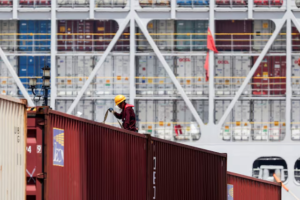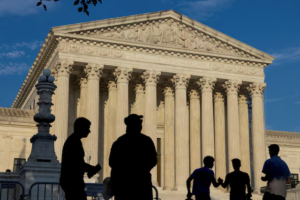In a move signaling one of Washington’s boldest military gestures in the Western Hemisphere in years, President Donald Trump’s administration has ordered the deployment of the USS Gerald R. Ford aircraft carrier strike group to Latin America. The decision marks a significant escalation in the ongoing U.S. military buildup in the Caribbean, officially framed as part of an intensified counter-narcotics operation.
A Show of Force Beyond Counter-Narcotics
The Gerald R. Ford, the world’s largest and most advanced aircraft carrier, joins a formidable U.S. presence in the region that already includes eight warships, a nuclear submarine, and F-35 fighter jets. Pentagon officials say the buildup aims to strengthen the United States’ ability to “detect, monitor, and disrupt” illicit trafficking networks that they claim threaten regional and domestic security.
“The enhanced U.S. force presence in the USSOUTHCOM area will bolster our capacity to confront illicit actors undermining safety and prosperity in the Western Hemisphere,” Pentagon spokesperson Sean Parnell stated on X (formerly Twitter). While no specific timeline was given for the carrier’s arrival, naval trackers show the Ford recently passing through the Strait of Gibraltar en route from Europe.
Commissioned in 2017, the USS Gerald R. Ford houses more than 5,000 sailors and can carry over 75 aircraft, including F/A-18 Super Hornets and E-2 Hawkeye early warning aircraft. Its sophisticated radar systems and missile arsenal, such as the Evolved Sea Sparrow Missile, make it a floating fortress of air and sea dominance. The group also includes the Ticonderoga-class cruiser USS Normandy and several Arleigh Burke-class destroyers, each equipped for anti-air, surface, and submarine warfare.
Rising Regional Tensions

The deployment comes amid worsening relations between Washington and Venezuela, where U.S. officials have long accused President Nicolás Maduro of harboring drug traffickers and eroding democracy. Since early September, U.S. forces have reportedly conducted ten strikes against suspected drug vessels in the Caribbean, killing around 40 people, including several Venezuelans.
Maduro, who has repeatedly accused Washington of seeking regime change, lashed out at the announcement.
“If the U.S. intervenes militarily in Venezuela, the working class will rise in a general insurrection,” he warned Thursday. “Millions of men and women with rifles will defend our homeland.”
The U.S. government has intensified its pressure campaign on Maduro, doubling its reward to $50 million for information leading to his capture on drug trafficking charges — allegations he strongly denies.
Colombia Pulled Into the Fray
Adding to regional volatility, Trump recently accused Colombian President Gustavo Petro of being a “drug leader” and “bad guy,” remarks Bogotá described as “offensive and reckless.” Soon after, Washington imposed new sanctions on Petro, citing alleged narcotics links.
Analysts warn that the escalating rhetoric and punitive actions risk straining decades of U.S.-Colombian cooperation and could destabilize counter-narcotics efforts in the region.
CIA Covert Authorization and Expanding Operations
Multiple reports indicate that President Trump has authorized the CIA to conduct covert operations in Venezuela, expanding U.S. intelligence activities as part of its anti-narcotics and anti-corruption agenda. Defense Secretary Pete Hegseth confirmed that the administration plans to brief Congress on the ongoing military operations but emphasized that a formal declaration of war “is not necessary.”
On Friday, Hegseth revealed that a recent U.S. strike killed six suspected “narco-terrorists” in the Caribbean — one of the deadliest incidents since the operations began.
Domestic and International Reaction
While Republican lawmakers praised the move as a decisive stand for national security, Democratic officials and legal experts expressed concern over the legality of using military force without congressional authorization or clear evidence linking the targets to drug cartels.
“President Trump is not messing around when it comes to protecting the U.S. and our Western Hemisphere neighborhood,” Representative Rick Crawford (R-AR) posted on X.
Critics, however, argue that the aggressive posture risks turning a counter-narcotics mission into a proxy conflict that could drag the U.S. into a wider confrontation with leftist governments across Latin America.
A Rare and Costly Deployment
With only 11 active aircraft carriers in the U.S. Navy, deploying one to Latin America underscores the strategic weight Washington places on this operation. Normally, carrier movements are scheduled years in advance for exercises or deterrence missions — such as last year’s USS George Washington deployment to South America.
The Ford’s arrival, by contrast, reflects an unprecedented and rapid escalation, signaling that the Trump administration intends to project power well beyond routine anti-drug patrols.
As the carrier group sails toward the Caribbean, the region braces for a period of heightened tension — a reminder that Washington’s reach remains formidable, and that Latin America is once again emerging as a critical stage for U.S. military and geopolitical influence.




